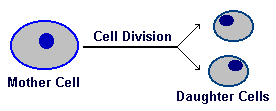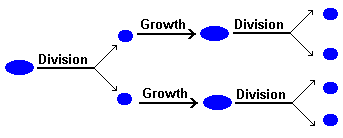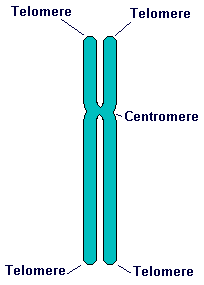
|
Lesson One
by Dr Jamie Love |

|
 and
and  licensed under a Creative Commons Attribution-ShareAlike 4.0 International License.
licensed under a Creative Commons Attribution-ShareAlike 4.0 International License.

|
Lesson One
by Dr Jamie Love |

|
All living things "start" as a single cell and a cell is the smallest most fundamental unit of life - by definition. (I put the word "start" in quotes because, in point of fact, life started billions of years ago and has maintain an unbroken chain of life ever since.) Cells are a very complex, highly organized form of matter. The instructions to build a cell are coded as genetic information - in its genes.
In this course I will teach you how that information is passed from cell to cell and from generation to generation. Genetic information defines a species, lays the foundation upon which we develop as individuals and represents an evolutionary heritage that extends back in time for billions of years.
Cell numbers increase by cell division.
All cells are descendants from cells that have divided and cells must divide to produce ancestors.
Note (for those who get confused with two important terms): descendants "follow" (kids follow parents so kids are descendants of their parents) but ancestors "precede" (parents are ancestors to their children). Your ancestry extends back backwards to your parents, their parents, etc. - for billions of years (through many now-extinct species). Your descendants, assuming you have any, will exist in future generations.

|
That makes it difficult to keep track of what cell we are talking about so
we have to be clear about who is the parent of whom.
By definition a mother cell divides into two daughter cells. Each cell division is a cellular "generation" in which a parent (mother cell) gives rise to offspring (two daughter cells). |
Some organisms are nothing more than a single cell "all their life" so we call them unicellular (organisms). These organisms make up most of the life on Earth but we easily overlook them because they are microscopic. Cell division is a cell's way of reproducing. The cell divides into two cells that usually look identical. For this reason, cell division is sometimes called "binary fission" to emphasize that a cell has split into two exact copies. After cell division the two unicellular organisms usually drift apart. If they do stay together it is only as a primitive clump of cells with no complex organization or specialization.
Organisms such as you and I are a collection of many cells, so we are called multicellular (organisms). We have specialized cells performing specialized functions but almost every cell in our body has the same genetic information. The differences among our cells are due to how they use that information, but that is an advanced topic so I won't go into it here. Some multicellular organisms reproduce by a method very similar to simple cell division - they just split into two pieces! But most multicellular organisms reproduce by a more complicated method that I will tell you about shortly. It is important to understand that all multicellular organisms start as a single cell. We become multicellular by a series of cell divisions very similar to the way unicellular organisms reproduce, but instead of drifting apart as two separate cells, most of our cells stick together and eventually organize themselves into a specialized "colony" that grows into a multicellular organism.
Hmmm, are humans a multicellular species or a unicellular one?
"Multicellular" I hear you say and you are correct -
sort of.
Although many textbooks and teachers like to divide species into
unicellular and multicellular it is not entirely correct to do
so. At one time I was only one cell. You, too, were only one cell
at one time - but you out grew it!  You went from a single cell
to a multicellular organism.
You went from a single cell
to a multicellular organism.
Think about this.
There are about 100 trillion (1014) cells in your body.
All of these cells were derived from multiple cell divisions
and, with minor exceptions, every cell in your body contains the
same genetic information. Each cell inherited that genetic information
from a previous cell and we can track that information all the
way back to your first cell when you where nothing more than a
"zygote".
A zygote is a single cell created by the union of two sex
cells which are called gametes. Male gametes are sperm
cells while female gametes are egg cells.
A zygote soon undergoes cell division and becomes two cells. Both
of those cells then divide to make four cells. Those four cells
divide to make eight cells, eight cells divide to make sixteen cells,
and so it goes. Nine months later a baby is born. That baby is
made of trillions of cells and all of them are descendants of
the single-celled zygote.
Cell division, especially in multicellular organisms, is under
careful control. Imagine what would happen if all the cells in
a baby underwent just one extra cell division. That baby would
be twice as big. And babies are big enough - ask any woman who
has given birth to one! 
The exact way a cell uses its genetic information controls how that cell will "behave" and that behavior causes the cell to organize in special ways, produce specific proteins and carry out certain functions. That specialization is the key to the success of multicellular organisms.
If the genetic information is lost or corrupted that cell and ALL its descendants will contain that error. These genetic errors are called mutations. Errors in genetic information can cause diseases like cancer or cystic fibrosis and birth defects such as Down syndrome or contribute to cleft palate. However, errors in genetic information are the fuel that feeds evolution and thus create the great diversity of species and individuals.
|
Each cell grows in size between each cell division. This "growth
phase" is an important time for a cell because during growth
a cell feeds and increases in size. If there were no cell growth
between divisions the cells would divide and divide until nothing
remained!
Cell growth has very little to do with genetics but it is an important part of a cell's life so it is important to understand it. |

|
Genetic information is contained in a very long molecule called
DNA. That stands for "DeoxyriboNucleic Acid",
a term that will have more meaning to you later. Like letters
in a word or words in a sentence, DNA's message provides information
for the cell.
DNA is often described as a cell's "blueprint" and I
think that is an excellent way to look at it.
|
In a later course you will learn exactly how DNA replicates
so we will not be going into that now. However, you should understand
that throughout this lesson and most of the lessons that follow
I will be talking about "double-stranded DNA".
At no time in cell division, and indeed rarely in the cell, is the DNA ever single-stranded. If this "single-stranded" versus "double-stranded" explanation only confuses you, don't worry about it. I just want to bring it to your attention now in case you've heard those terms from before and are wondering how they fit in to this lesson. |
Long stretches of DNA are organized into chromosomes.
Bacteria have very primitive chromosomes made of almost
nothing but DNA. That is good enough for bacteria because they
don't have very large amounts of genetic information. All other
forms of life require larger amounts of information so they require
more DNA. To hold all that extra information together in a nice
"package", all non-bacterial chromosomes have proteins
associated with the DNA. These proteins help organize the long
strands of DNA and simplify the passage of the DNA from one generation
to the next.
Most organisms are so complex that they need several chromosomes
to carry their entire DNA.
During cell division it is extremely important that the daughter cells inherit the correct and complete chromosome(s) from their mother cell. I will spend the next few lessons teaching you the details of this process but in this lesson I just want to introduce the subject.
Earlier I divided life into unicellular and multicellular. That
is a good way to look at cells but there is better way to think
about them and that has to do with the way they contain their
DNA (chromosomes).
Eukaryotes are organisms that hold their chromosomes in
a nucleus. Most species are eukaryotes. In fact, eukaryotes
have many other things (organelles) in them beside a nucleus but, by definition,
all eukaryotes have a nucleus. People are eukaryotes.
Prokaryotes do not have a nucleus so their genetic material
is free to float around throughout the cell. All bacteria, including "blue-green algae", are prokaryotes.
Everything else that's alive is a eukaryote. (Viruses are not alive.)
Let's start with a look at prokaryotes because they are very simple
and easy to understand.
All prokaryotes have a single, "naked" [no bound proteins - just naked] (double) strand of DNA, as a circular chromosome.
| Many prokaryotes also have plasmids - tiny, circular "pseudochromosomes" of DNA that confer special properties to the cell such as resistance to certain antibiotics. Let's ignore plasmids for now. |
|
Prokaryotes have only one type of cell division - fission.
It's really nothing more than cell division but let's discuss
the specifics of fission as it applies to prokaryotes.
Before fission the cell makes a copy of its DNA so that it now
has two copies of its genetic material.
One copy is distributed to each half of the cell. This is done
in a specific manner but we do not need to go into the details yet.
Suffice it to say that mechanisms are in place to ensure that
one copy of DNA goes to each side of the cell.
Any other materials inside the cell are distributed between the
two halves at random. That's OK because it doesn't matter if one cell gets more cytoplasm or ribosomes than the other. What matters is that both cells end up with identical copies
of genetic information. That's why there are mechanisms in place
to ensure that each cell gets a copy of the chromosome (DNA).
|

|
That's the life of a prokaryote but what about eukaryotes like
us?
Eukaryotic cells have a more
complex genetic system - complex in terms of how they package their
DNA and complex in terms of how they distribute it in cell division.
Eukaryotes package their genetic information in chromosomes that are very different from prokaryotic chromosomes. Each eukaryotic chromosome contains a linear length of (double-stranded) DNA. Eukaryotic chromosomes also contain a lot of protein.
|
Two types of those proteins are worth mentioning.
Nucleosomes are special proteins upon which the DNA is wound in a specific manner. They help to keep the DNA "condensed" in much the same way that a spool keeps a long length of thread condensed by wrapping the thread around it. "Scaffolding proteins" organize the nucleosome bound DNA into the structures that we see under a microscope as a chromosome. Each (double) strand of DNA, along with its associated scaffolding proteins, gives the chromosome its shape. |
This complex of DNA and protein is called chromatin. So
a eukaryotic chromosome is made of chromatin (DNA and proteins)
but a prokaryotic chromosome is just "naked" DNA. [That
is an important definition of chromatin AND an important distinction
between eukaryotic versus prokaryotic chromosomes - so memorize
it!  ]
]
Chromosomes can only be seen during division. Between divisions,
while a cell is growing, the chromosomes are "unwound" from many of the nucleosomes and scaffolding proteins. That
makes the DNA available for the cell to use in processes called
transcription and duplication that you'll hear more about in one of our more advanced courses.
Unwound DNA cannot be seen with a normal microscope because the
DNA is "decondensed".
As the cell approaches cell division it winds the DNA up tightly
in the proteins causing the chromosomes to "condense". These
condensed chromosomes are visible with a normal microscope and
they are what we will be talking about a great deal in subsequent lessons.
If all the DNA from just one of your cells was stretched out (decondensed) and linked into a single line, it would be almost two meters long. That's about the height of a man! Obviously, the proteins that condense the DNA are very important to pack all that information into a nucleus.
But why is it easier to see (with a microscope) condensed DNA?
After all, wouldn't it be easier to see something nearly two meters
long than something so small it fits in a nucleus!
This point often confuses students but think about it. Isn't it
easier to see a ball of hair (all clumped up) than a strand of
hair? You see, length isn't everything. Width counts too. Something
will appear invisible to you no matter how long it is if it is
extremely thin.
A common falsehood is that the Great Wall of China can be seen
from the surface of the Moon (without magnification). It cannot. It's far too thin
from that distance. It is true that the two points that define
its ends can be resolved from that distance but that doesn't make
the Wall visible. On the other hand, the Pyramid of Cheops, which
is both long AND wide, can be seen from Earth orbit with little
magnification. Now, if we were to bulldoze the Great Wall of China
into a square pile it would have both length and height making
it more visible from a distance. 
My point is not to teach you high altitude surveying but to help you appreciate why condensed DNA is visible under a microscope with only moderate magnification but uncondensed DNA is not. |
During most stages of cell divisions we see the chromosomes as X-shaped objects composed of two "chromatids".

|
The ends of the chromatids are called telomeres ("telos"
is Greek for "end)" and the point were they are joined
is called a centromere although it isn't always at the
center.
It is important to understand that these X-shaped chromosomes are made of two identical pieces of (double-stranded) DNA. That is, the "left side" is identical to the "right side". These "arms and legs" are NOT the two complementary "single-strands" of DNA that you will see when we talk about DNA structure and duplication (in Molecular Genetics)! When I say they are identical I mean identical! Not complementary. Not mirror images. We call these "arms and legs" chromatids. More correctly, one "arm and leg" makes one chromatid and the other "arm and leg" forms the other chromatid. [Don't confuse the word "chromatid" with "chromosome" or "chromatin" - they look and sound similar but have different meanings.] |

|
Because they are identical the two chromatids on the same chromosomes are called sister chromatids.
These chromosome structures will become more important when I teach you how chromosomes behave during nuclear division but you should learn them now in order to get comfortable with these words and chromosome structure.

Mitosis produces identical nuclei ("nuclei"
is plural for nucleus) so it is similar to prokaryote fission
BUT it is not the same in detail. Mitosis is the dominant type
of nuclear division and its purpose is to increase the number
of nuclei. This usually leads to an increase in cell numbers, with
each cell containing one nucleus, so people often say - incorrectly -
that mitosis increases cell numbers. Most mitosis is followed
by cell division so most of the time mitosis increases cell numbers
but mitosis only increases the number
of nuclei.
The nuclear divisions that turn one zygote nucleus into trillions
of nuclei to make a baby are all mitotic divisions followed
by cell divisions.
Note: mitosis is used in asexual reproduction - reproduction
without sex. (Vegetative propagation, cloning, budding, etc.)
More on that is a subsequent lesson.
Meiosis produces diverse nuclei and that makes meiosis "doubly complicated" to most students. Meiosis is a very specialized type of nuclear division occurring only in cells that will become gametes (sex cells - sperm and egg). So meiosis is required for sexual reproduction; reproduction using gametes.
You might think that meiosis is of little significance to this course because it is such an insignificant part of "life". You would be wrong! A clear understanding of meiosis is essential in order to understand genetics - the study of heredity.
This lesson and the next six lessons deal with "cell genetics" or more correctly cytogenetics. Of course, the genetics of a cell are the genetics of life so this information is fundamental to your understanding of genetics in general. The word "cytogenetics" deals mostly with things that can be seen through a normal microscope and most of the time we are talking about chromosomes.
This introduction, like the introduction to most courses, presents important definitions and concepts that you will be using throughout the rest of this course and throughout your
career if you decide to become a biologist.
The Self Assessment Questions (SAQs) should help reinforce those
ideas.
 and
and  licensed under a Creative Commons Attribution-ShareAlike 4.0 International License.
licensed under a Creative Commons Attribution-ShareAlike 4.0 International License.
| Table of Contents | Homepage | How to get a FREE copy of the entire course (hypertextbook) | Frequently Asked Questions |